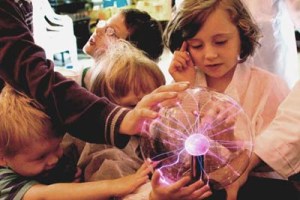As a mother I have watched with fascination at how my children grow and learn, constantly testing, evaluating and questioning life around them. For Newton (at the age of 23) it was apparently an apple from a tree that led to his evaluation of gravity but have you ever observed a toddler in a high chair dropping their spoon? Every parent I know has gone through this phase with eventual exasperation, but look at it through the child’s eyes…. why does it always fall down? Why does it not fall upwards and stick to the ceiling? Over and over again they test their results, natural scientists!
It has become an interest of mine to observe how our environment, lifestyles and educational facilities feed this wealth of natural scientific curiosity. As my children passed through playschool and Montessori I observed the wonderful manner of learning and development through play and interaction that is encouraged through the guidelines of Aistear (the Early Childhood Curriculum Framework).
“Tell me and I forget; show me and I may remember; involve me and I learn.” Benjamin Franklin
Now that my older children have moved into primary school I notice things are very different from my day. Technology has made it to the classroom! Chalk and blackboard have largely been replaced with interactive white boards and computers.
 The internet has opened up a wealth of learning for our children where they can link to others on an international level to promote their learning in STEM (Science, Technology, Engineering and Maths) subjects. Our local school uses Manga High for interactive maths games, quizzes and learning. Children are being educated in computers and programming technology through the global collaboration that is CoderDojo!
The internet has opened up a wealth of learning for our children where they can link to others on an international level to promote their learning in STEM (Science, Technology, Engineering and Maths) subjects. Our local school uses Manga High for interactive maths games, quizzes and learning. Children are being educated in computers and programming technology through the global collaboration that is CoderDojo!
What about how science is taught in our primary schools? The curriculum encourages children to learn through investigation and exploration of their physical and natural surroundings. Teachers are encouraged to promote hands-on learning and it is certainly a requirement in the training of new teaching staff. Online resources are available to encourage and assist in the teaching of science in the classroom. The reality depends on how comfortable the teacher feels with the subject, the class sizes and time! In my experience of bringing interactive science to the classroom, I have found the two types of teachers that show the most enthusiasm for what I do are those that are madly into science themselves and those that are totally intimidated by it!
Outside of the school environment there is more to stimulate the young scientist than ever before. The Aquarium is a favourite in our family, as is the Zoology department at our local University. We took in an interactive display on oscillation at the Science Gallery, on our last trip to Dublin. The National History Museum is next on our list along with a science walking tour. School holidays can now be filled with science camps, construction camps and outdoor nature workshops, to name but a few.
My observations have shown me how much has changed since my school days. I learnt science from a book with little emphasis on questioning. I am pleased to see that my children learn in an environment that encourages questioning and active exploration. Just as they began their scientific enquiry with the early dropping of the spoon, they are moving through a life that is rich in scientific options, wonder and promotion. It is even written into their school curriculum! I have also learnt through my children, I am learning now more than ever, by simply….. looking at life through the eyes of a child!
This article originally appeared as a “guest post” on sciencecalling.com